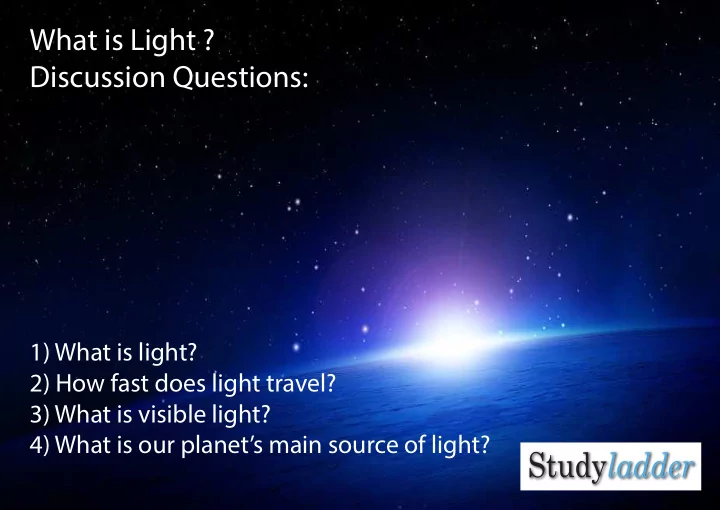

What is Light ? Discussion Questions: 1) What is light? 2) How fast does light travel? 3) What is visible light? 4) What is our planet’s main source of light?
electric field travels in a vertical plane What is Light? direction of travel Light is a type of electromagnetic energy. It comes from the Sun and travels in tiny vibrating waves. magnetic field Each wave consists of a wave of electricity and a travels in a horizontal plane wave of magnetism which travel at right angles to each other. The direction of the light’s movement is a straight line. Scientists have long debated about the true nature of light. Sir Isaac Newton (1642 -1727) was one of the first scientists to argue that light was a series of particles streaming in the one direction. Christiaan Huygens (1629 -1695) was one of the first to state that light travelled in waves. Scientists today believe that the behaviour of light is complex. Studies indicate that light can travel in waves in some circumstances and as a stream of particles in others. They believe that light energy Sir Isaac Newton Christiaan Huygens displays elements of both theories so they British Scientist Dutch Scientist describe light as having wave-particle duality .
Light is a type of electromagnetic radiation. Other types of elecromagnetic radiation include microwaves, radiowaves and xrays. Visible light is not harmful to our bodies but ultraviolet light causes damage to the skin (sunburn) and can lead to skin cancers. Light travels in waves and it is very fast. In a vacuum, light travels at 299 792 458 metres per second.
The Speed of Light Light travels at 299 792 458 metres per second in a vacuum. That’s about 300 000 km per second ! (180 000 miles per second.) Distances in space are so vast that we refer to them in light years . A light year is the distance light can travel in a year. That’s approximately 9.5 trillion km (5.9 trillion miles). Light from the Sun takes approximately 8.3 minutes to reach us on the Earth. Our nearest neighbouring star is Alpha Centauri. It is 4.3 light years away from our Sun. But we can’t travel at the speed of light. The Voyager 1 Space Probe was launched in 1977. It has travelled a great distance, taking photographs of our solar system on its way. In 2013 scientists confirmed that Voyager 1 has left our solar system, travelling at a speed of 60 000 km per hour (37 000 miles per hour.) At this speed it will take the space probe 80 000 years to get to our closest neighbouring star!
Recommend
More recommend